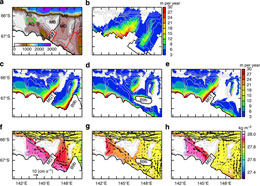Research Abstract
メルツ氷河舌の分離が高密度水形成/流出量に与える影響
本研究では、最新の海氷–海洋モデルを用いてその海氷および海洋場への影響を評価した。
Impact of the Mertz Glacier Tongue calving on dense water formation and export
2011年1月18日 Nature Communications 2 : 159 doi: 10.1038/ncomms1156

南極底層水(AABW)は世界の海洋の深層を占め、その沈み込み過程は海洋の子午面循環を駆動しており、地球の気候システムの重要な構成要素である。東南 極域では、効率的に海氷が生成される沿岸ポリニヤにおいて、AABWの元となる高密度陸棚水(DSW)が大量に形成されている。オーストラリア–南極海盆 へ供給されるAABWを主に形成しているのは、アデリー・ジョージ5世海岸付近の沿岸ポリニヤである。そこでは、これまでアデリーディプレッション上にせ り出したメルツ氷河舌(MGT)とメルツディプレッション上に存在した座礁氷山B9bの西側/風下側に形成されるポリニヤにおいて、活発なDSW形成が行 われていた。しかし、2010年2月12日から13日にかけてMGTが南極大陸内部の氷河から分離し、そこでのDSW形成環境場を劇的に変化させた。本研 究では、最新の海氷–海洋モデルを用いてその海氷および海洋場への影響を評価した。モデル結果から、MGT分離後すぐに海洋循環場と海氷生成のパターンが 変化し、DSW流出量がMGT分離前に比べて23%減少しうることがわかった。
- 東京大学 大気海洋研究所
- ピエール・マリー・キュリー大学(仏)
Antarctic Bottom Water (AABW) is a critical component of the global climate system, occupying the abyssal layer of the World Ocean and driving the lower limb of the global meridional overturning circulation. Around East Antarctica, the dense shelf water (DSW) precursor to AABW is predominantly formed by enhanced sea ice formation in coastal polynyas. The dominant source region of AABW supply to the Australian–Antarctic Basin is the Adélie and George V Land coast, in particular, polynyas formed in the western lee of the Mertz Glacier Tongue (MGT) and the grounded iceberg B9b over the Adélie and the Mertz Depressions, respectively. The calving of the MGT, which occurred on 12–13 February 2010, dramatically changed the environment for producing DSW. Here, we assess its impact using a state-of-the-art ice-ocean model. The model shows that oceanic circulation and sea ice production in the region changes immediately after the calving event, and that the DSW export is reduced by up to 23%.

